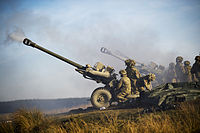
Photo from wikipedia
Abstract Recent casualties in volcanic eruptions due to trauma from blocks and bombs necessitate more rigorous, ballistic specific risk assessment. Quantitative assessments are limited by a lack of experimental and… Click to show full abstract
Abstract Recent casualties in volcanic eruptions due to trauma from blocks and bombs necessitate more rigorous, ballistic specific risk assessment. Quantitative assessments are limited by a lack of experimental and field data on the vulnerability of buildings to ballistic hazards. An improved, quantitative understanding of building vulnerability to ballistic impacts is required for informing appropriate life safety actions and other risk reduction strategies. We assessed ballistic impacts to buildings from eruptions at Usu Volcano and Mt. Ontake in Japan and compiled available impact data from eruptions elsewhere to identify common damage patterns from ballistic impacts to buildings. We additionally completed a series of cannon experiments which simulate ballistic block impacts to building claddings to investigate their performance over a range of ballistic projectile velocities, masses and energies. Our experiments provide new insights by quantifying (1) the hazard associated with post-impact shrapnel from building and rock fragments; (2) the effect of impact obliquity on damage; and (3) the additional impact resistance buildings possess when claddings are struck in areas directly supported by framing components. This was not well identified in previous work which may have underestimated building vulnerability to ballistic hazards. To improve assessment of building vulnerability to ballistics, we use our experimental and field data to develop quantitative vulnerability models known as fragility functions. Our fragility functions and field studies show that although unreinforced buildings are highly vulnerable to large ballistics (> 20 cm diameter), they can still provide shelter, preventing death during eruptions.
Journal Title: Journal of Volcanology and Geothermal Research
Year Published: 2017
Link to full text (if available)
Share on Social Media: Sign Up to like & get
recommendations!